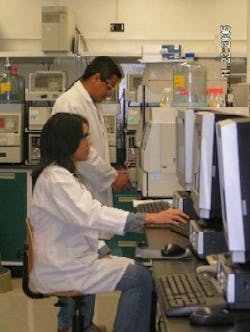Lean is not all about automation. Here, Arecibo operators insert leaflets into drug packages.
|
Two months ago, the company announced plans to close or sell off five of its manufacturing sites and lay off 7,000 people, many of them in manufacturing. “Merck has been a bastion of stability for so long, but it’s now taking after the rest of the industry,” says Cheryl Buxton, managing director, life sciences for the staffing firm Korn/Ferry International.Issues with Vioxx may have dealt a blow to Merck’s reputation, but the company is taking quick and decisive steps to restore the public’s trust and to improve quality and performance. During the fourth quarter of 2004, Merck’s senior management first articulated a new supply strategy with the modest goal of becoming “the most trusted and competitive supplier of medicines and vaccines in the world.”Helping Merck get there, company management believes, will be the Merck Production System (MPS), an operational excellence strategy that combines elements of Lean Manufacturing, Six Sigma and Overall Equipment Effectiveness (OEE). At the core of MPS are the Lean principles of customer value, demand pull, continuous flow of product and information, waste elimination and the pursuit of excellence, explains Martin Khun, global leader for MPS at Merck.“Through the MPS operating model, we will create a competitive, customer-focused supply chain,” says Sue Capps Morris, vice president of pharmaceutical operations, the Americas, and the program’s executive sponsor. “Our customers will receive what they want, when they want it, and we will provide value at every step,” she says.Merck selected its 800-employee manufacturing facility in Arecibo, Puerto Rico, as the pilot site for its MPS strategy. Not only is Arecibo strategically important, but it encompasses a diverse set of business models, including toll processing and contract finishing operations as well as Merck’s own drug manufacturing lines, explains Daneris Fernandez, vice president of Merck’s operations in Puerto Rico. “Our plan needed to be as comprehensive as possible, to cover all possible business models,” she says.MPS is now being rolled out in Merck’s Wilson, N.C., facility and at one of its plants in the U.K. The strategy will also be implemented at the company’s other plants in Puerto Rico in 2007, starting with Barceloneta, where Value Stream Mapping and preliminary data gathering have already begun, Fernandez says. The complexity of Arecibo’s operations should help make the lessons learned there easier to transfer to other Merck facilities.A cross-functional team of 30 people, led by site MPS manager Herminio Bosques, drove the effort at the facility. Members of the team came from various parts of the organization: business departments, including planning and procurement; quality assurance and control; human resources; and production.Some team managers had experience outside of pharma, and outside consultants were brought in to introduce best-in-class concepts and Lean transformational capabilities. Together with local management and executive sponsors, the team laid the foundation for MPS, developing the overall design and implementation.Managing the transition to Lean required a strategic plan for communication and training, one that would account for needs at all levels of the organization. At Arecibo, communications began from the top down, Fernandez says. Efforts first focused on ensuring that all executives understood the challenges ahead and why change was needed so that they could model the behavior required. “Hearing management theories is one thing, but real understanding is essential to ensuring buy-in,” Fernandez says. “We didn’t want to, simply, impose a new process.”Bosques’ team developed a communications plan tailored for different levels within the facility — one for executives, another for technical staff, and yet another for hourly employees. Engaging operators was every bit as important as reaching out to management. “We needed to have an impact at the manufacturing-floor level that would flow from the organization to the site, to the division,” Bosques says. Team member Jose Murali and his colleagues developed training videos, which were played during lunchtime in the company cafeteria, explaining the need for change.Establishing the right tone was important. Without being condescending, the message had to come through clearly. Hourly employees might be able to understand the concepts of cash flow and inventory, but the language of the Annual Report might not resonate as well with some of them as practical examples from every day life, Fernandez says. To communicate the idea of excess inventory, for example, one video for hourly workers used the example of someone stocking up on Aspirin, depleting the household budget, and holding on to material that would reach its expiration date before it could be used, a simple but effective demonstration of a problem that many drug manufacturing facilities face today.



